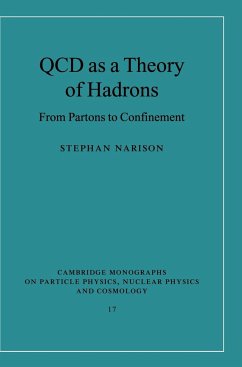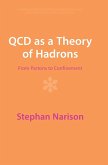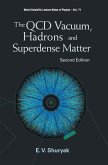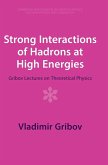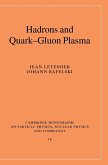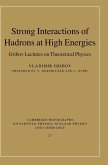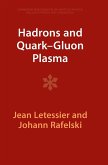Stephan Narison
QCD as a Theory of Hadrons
Stephan Narison
QCD as a Theory of Hadrons
- Gebundenes Buch
- Merkliste
- Auf die Merkliste
- Bewerten Bewerten
- Teilen
- Produkt teilen
- Produkterinnerung
- Produkterinnerung
An introduction to the basic theory and recent advances in QCD, for graduates and researchers.
Andere Kunden interessierten sich auch für
![QCD as a Theory of Hadrons QCD as a Theory of Hadrons]() Stephan NarisonQCD as a Theory of Hadrons172,99 €
Stephan NarisonQCD as a Theory of Hadrons172,99 €![QCD VACUUM, HADRONS & SUPER...(2ED)(V71) QCD VACUUM, HADRONS & SUPER...(2ED)(V71)]() Edward V ShuryakQCD VACUUM, HADRONS & SUPER...(2ED)(V71)246,99 €
Edward V ShuryakQCD VACUUM, HADRONS & SUPER...(2ED)(V71)246,99 €![Strong Interactions of Hadrons at High Energies Strong Interactions of Hadrons at High Energies]() Vladimir GribovStrong Interactions of Hadrons at High Energies128,99 €
Vladimir GribovStrong Interactions of Hadrons at High Energies128,99 €![Hadrons and Quark-Gluon Plasma Hadrons and Quark-Gluon Plasma]() Jean LetessierHadrons and Quark-Gluon Plasma188,99 €
Jean LetessierHadrons and Quark-Gluon Plasma188,99 €![Strong Interactions of Hadrons at High Energies Strong Interactions of Hadrons at High Energies]() Vladimir GribovStrong Interactions of Hadrons at High Energies182,99 €
Vladimir GribovStrong Interactions of Hadrons at High Energies182,99 €![Hadrons and Quark-Gluon Plasma Hadrons and Quark-Gluon Plasma]() Jean LetessierHadrons and Quark-Gluon Plasma128,99 €
Jean LetessierHadrons and Quark-Gluon Plasma128,99 €![Hadrons at Finite Temperature Hadrons at Finite Temperature]() Samirnath MallikHadrons at Finite Temperature114,99 €
Samirnath MallikHadrons at Finite Temperature114,99 €-
-
-
An introduction to the basic theory and recent advances in QCD, for graduates and researchers.
Hinweis: Dieser Artikel kann nur an eine deutsche Lieferadresse ausgeliefert werden.
Hinweis: Dieser Artikel kann nur an eine deutsche Lieferadresse ausgeliefert werden.
Produktdetails
- Produktdetails
- Verlag: Cambridge University Press
- Seitenzahl: 812
- Erscheinungstermin: 29. März 2018
- Englisch
- Abmessung: 250mm x 175mm x 48mm
- Gewicht: 1553g
- ISBN-13: 9780521811644
- ISBN-10: 0521811643
- Artikelnr.: 20989383
- Herstellerkennzeichnung
- Libri GmbH
- Europaallee 1
- 36244 Bad Hersfeld
- gpsr@libri.de
- Verlag: Cambridge University Press
- Seitenzahl: 812
- Erscheinungstermin: 29. März 2018
- Englisch
- Abmessung: 250mm x 175mm x 48mm
- Gewicht: 1553g
- ISBN-13: 9780521811644
- ISBN-10: 0521811643
- Artikelnr.: 20989383
- Herstellerkennzeichnung
- Libri GmbH
- Europaallee 1
- 36244 Bad Hersfeld
- gpsr@libri.de
About Stephan Narison
Outline of the book
Preface
Acknowledgements
Part I. General Introduction: 1. A short flash on particle physics
2. The pre-QCD era
3. The QCD story
4. Field theory ingredients
Part II. QCD Gauge Theory: 5. Lagrangian and gauge invariance
6. Quantization using path integral
7. QCD and its global invariance
Part III. MS scheme for QCD and QED: Introduction
8. Dimensional regularization
9. The MS renormalization scheme
10. Renormalization of operators using the background field method
11. The renormalization group
12. Other renormalization schemes
13. MS scheme for QED
14. High-precision low-energy QED tests
Part IV. Deep Inelastic Scattering at Hadron Colliders: 15. OPE for deep inelastic scattering
16. Unpolarized lepton-hadron scattering
17. The Altarelli-Parisi equation
18. More on unpolarized deep inelastic scatterings
19. Polarized deep-inelastic processes
20. Drell-Yan process
21. One 'prompt photon' inclusive production
Part V. Hard Processes in e+e- Collisions: Introduction
22. One hadron inclusive production
23. gg scatterings and the 'spin' of the photon
24. QCD jets
25. Total inclusive hadron productions
Part VI. Summary of QCD Tests and as Measurements
Part VII. Power Corrections in QCD: 26. Introduction
27. The SVZ expansion
28. Technologies for evaluating Wilson coefficients
29. Renormalons
30. Beyond the SVZ expansion
Part VIII. QCD Two-Point Functions: 31. References guide to original works
32. (Pseudo)scalar correlators
33. (Axial-)vector two-point functions
34. Tensor-quark correlator
35. Baryonic correlators
36. Four-quark correlators
37. Gluonia correlators
38. Hybrid correlators
39. Correlators in x-space
Part IX. QCD Non-Perturbative Methods: 40. Introduction
41. Lattice gauge theory
42. Chiral perturbation theory
43. Models of the QCD effective action
44. Heavy quark effective theory
45. Potential approaches to quarkonia
46. On monopole and confinement
Part X. QCD Spectral Sum Rules: 47. Introduction
48. Theoretical foundations
49. Survey of QCD spectral sum rules
50. Weinberg and DMO sum rules
51. The QCD coupling as
52. The QCD condensates
53. Light and heavy quark masses, etc.
54. Hadron spectroscopy
55. D, B and Bc exclusive weak decays
56. B0(s)-B0(s) mixing, kaon CP violation
57. Thermal behaviour of QCD
58. More on spectral sum rules
Part XI. Appendix A: physical constants and unites
Appendix B: weight factors for SU(N)c
Appendix C: coordinates and momenta
Appendix D: Dirac equation and matrices
Appendix E: Feynman rules
Appendix F: Feynman integrals
Appendix G: useful formulae for the sum rules
Bibliography
Index.
Outline of the book
Preface
Acknowledgements
Part I. General Introduction: 1. A short flash on particle physics
2. The pre-QCD era
3. The QCD story
4. Field theory ingredients
Part II. QCD Gauge Theory: 5. Lagrangian and gauge invariance
6. Quantization using path integral
7. QCD and its global invariance
Part III. MS scheme for QCD and QED: Introduction
8. Dimensional regularization
9. The MS renormalization scheme
10. Renormalization of operators using the background field method
11. The renormalization group
12. Other renormalization schemes
13. MS scheme for QED
14. High-precision low-energy QED tests
Part IV. Deep Inelastic Scattering at Hadron Colliders: 15. OPE for deep inelastic scattering
16. Unpolarized lepton-hadron scattering
17. The Altarelli-Parisi equation
18. More on unpolarized deep inelastic scatterings
19. Polarized deep-inelastic processes
20. Drell-Yan process
21. One 'prompt photon' inclusive production
Part V. Hard Processes in e+e- Collisions: Introduction
22. One hadron inclusive production
23. gg scatterings and the 'spin' of the photon
24. QCD jets
25. Total inclusive hadron productions
Part VI. Summary of QCD Tests and as Measurements
Part VII. Power Corrections in QCD: 26. Introduction
27. The SVZ expansion
28. Technologies for evaluating Wilson coefficients
29. Renormalons
30. Beyond the SVZ expansion
Part VIII. QCD Two-Point Functions: 31. References guide to original works
32. (Pseudo)scalar correlators
33. (Axial-)vector two-point functions
34. Tensor-quark correlator
35. Baryonic correlators
36. Four-quark correlators
37. Gluonia correlators
38. Hybrid correlators
39. Correlators in x-space
Part IX. QCD Non-Perturbative Methods: 40. Introduction
41. Lattice gauge theory
42. Chiral perturbation theory
43. Models of the QCD effective action
44. Heavy quark effective theory
45. Potential approaches to quarkonia
46. On monopole and confinement
Part X. QCD Spectral Sum Rules: 47. Introduction
48. Theoretical foundations
49. Survey of QCD spectral sum rules
50. Weinberg and DMO sum rules
51. The QCD coupling as
52. The QCD condensates
53. Light and heavy quark masses, etc.
54. Hadron spectroscopy
55. D, B and Bc exclusive weak decays
56. B0(s)-B0(s) mixing, kaon CP violation
57. Thermal behaviour of QCD
58. More on spectral sum rules
Part XI. Appendix A: physical constants and unites
Appendix B: weight factors for SU(N)c
Appendix C: coordinates and momenta
Appendix D: Dirac equation and matrices
Appendix E: Feynman rules
Appendix F: Feynman integrals
Appendix G: useful formulae for the sum rules
Bibliography
Index.
About Stephan Narison
Outline of the book
Preface
Acknowledgements
Part I. General Introduction: 1. A short flash on particle physics
2. The pre-QCD era
3. The QCD story
4. Field theory ingredients
Part II. QCD Gauge Theory: 5. Lagrangian and gauge invariance
6. Quantization using path integral
7. QCD and its global invariance
Part III. MS scheme for QCD and QED: Introduction
8. Dimensional regularization
9. The MS renormalization scheme
10. Renormalization of operators using the background field method
11. The renormalization group
12. Other renormalization schemes
13. MS scheme for QED
14. High-precision low-energy QED tests
Part IV. Deep Inelastic Scattering at Hadron Colliders: 15. OPE for deep inelastic scattering
16. Unpolarized lepton-hadron scattering
17. The Altarelli-Parisi equation
18. More on unpolarized deep inelastic scatterings
19. Polarized deep-inelastic processes
20. Drell-Yan process
21. One 'prompt photon' inclusive production
Part V. Hard Processes in e+e- Collisions: Introduction
22. One hadron inclusive production
23. gg scatterings and the 'spin' of the photon
24. QCD jets
25. Total inclusive hadron productions
Part VI. Summary of QCD Tests and as Measurements
Part VII. Power Corrections in QCD: 26. Introduction
27. The SVZ expansion
28. Technologies for evaluating Wilson coefficients
29. Renormalons
30. Beyond the SVZ expansion
Part VIII. QCD Two-Point Functions: 31. References guide to original works
32. (Pseudo)scalar correlators
33. (Axial-)vector two-point functions
34. Tensor-quark correlator
35. Baryonic correlators
36. Four-quark correlators
37. Gluonia correlators
38. Hybrid correlators
39. Correlators in x-space
Part IX. QCD Non-Perturbative Methods: 40. Introduction
41. Lattice gauge theory
42. Chiral perturbation theory
43. Models of the QCD effective action
44. Heavy quark effective theory
45. Potential approaches to quarkonia
46. On monopole and confinement
Part X. QCD Spectral Sum Rules: 47. Introduction
48. Theoretical foundations
49. Survey of QCD spectral sum rules
50. Weinberg and DMO sum rules
51. The QCD coupling as
52. The QCD condensates
53. Light and heavy quark masses, etc.
54. Hadron spectroscopy
55. D, B and Bc exclusive weak decays
56. B0(s)-B0(s) mixing, kaon CP violation
57. Thermal behaviour of QCD
58. More on spectral sum rules
Part XI. Appendix A: physical constants and unites
Appendix B: weight factors for SU(N)c
Appendix C: coordinates and momenta
Appendix D: Dirac equation and matrices
Appendix E: Feynman rules
Appendix F: Feynman integrals
Appendix G: useful formulae for the sum rules
Bibliography
Index.
Outline of the book
Preface
Acknowledgements
Part I. General Introduction: 1. A short flash on particle physics
2. The pre-QCD era
3. The QCD story
4. Field theory ingredients
Part II. QCD Gauge Theory: 5. Lagrangian and gauge invariance
6. Quantization using path integral
7. QCD and its global invariance
Part III. MS scheme for QCD and QED: Introduction
8. Dimensional regularization
9. The MS renormalization scheme
10. Renormalization of operators using the background field method
11. The renormalization group
12. Other renormalization schemes
13. MS scheme for QED
14. High-precision low-energy QED tests
Part IV. Deep Inelastic Scattering at Hadron Colliders: 15. OPE for deep inelastic scattering
16. Unpolarized lepton-hadron scattering
17. The Altarelli-Parisi equation
18. More on unpolarized deep inelastic scatterings
19. Polarized deep-inelastic processes
20. Drell-Yan process
21. One 'prompt photon' inclusive production
Part V. Hard Processes in e+e- Collisions: Introduction
22. One hadron inclusive production
23. gg scatterings and the 'spin' of the photon
24. QCD jets
25. Total inclusive hadron productions
Part VI. Summary of QCD Tests and as Measurements
Part VII. Power Corrections in QCD: 26. Introduction
27. The SVZ expansion
28. Technologies for evaluating Wilson coefficients
29. Renormalons
30. Beyond the SVZ expansion
Part VIII. QCD Two-Point Functions: 31. References guide to original works
32. (Pseudo)scalar correlators
33. (Axial-)vector two-point functions
34. Tensor-quark correlator
35. Baryonic correlators
36. Four-quark correlators
37. Gluonia correlators
38. Hybrid correlators
39. Correlators in x-space
Part IX. QCD Non-Perturbative Methods: 40. Introduction
41. Lattice gauge theory
42. Chiral perturbation theory
43. Models of the QCD effective action
44. Heavy quark effective theory
45. Potential approaches to quarkonia
46. On monopole and confinement
Part X. QCD Spectral Sum Rules: 47. Introduction
48. Theoretical foundations
49. Survey of QCD spectral sum rules
50. Weinberg and DMO sum rules
51. The QCD coupling as
52. The QCD condensates
53. Light and heavy quark masses, etc.
54. Hadron spectroscopy
55. D, B and Bc exclusive weak decays
56. B0(s)-B0(s) mixing, kaon CP violation
57. Thermal behaviour of QCD
58. More on spectral sum rules
Part XI. Appendix A: physical constants and unites
Appendix B: weight factors for SU(N)c
Appendix C: coordinates and momenta
Appendix D: Dirac equation and matrices
Appendix E: Feynman rules
Appendix F: Feynman integrals
Appendix G: useful formulae for the sum rules
Bibliography
Index.

